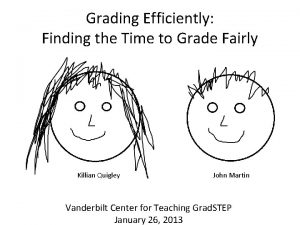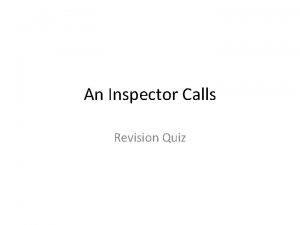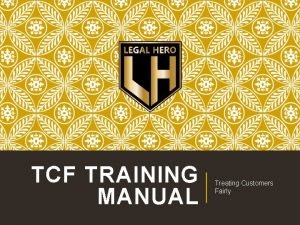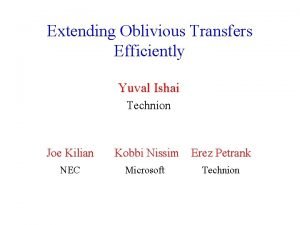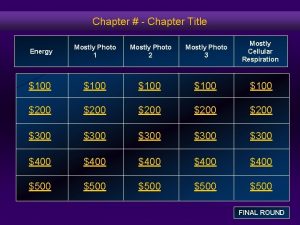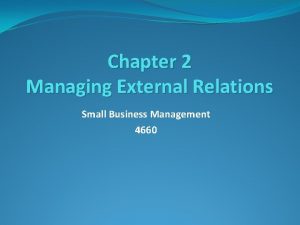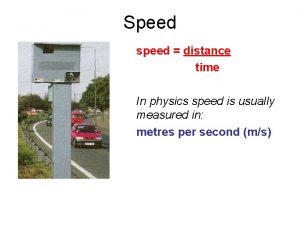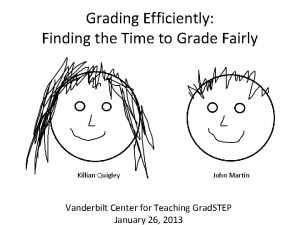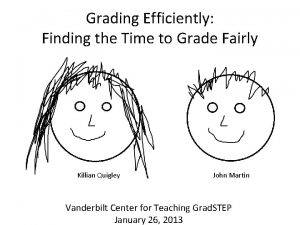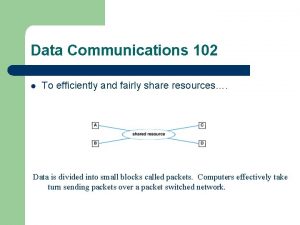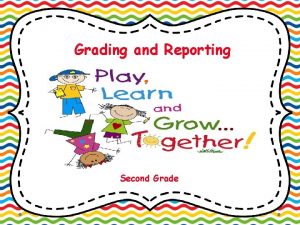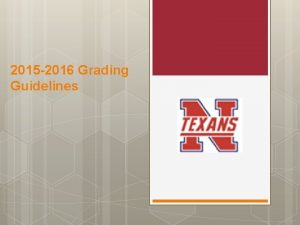Grading Efficiently Finding the Time to Grade Fairly



































- Slides: 35

Grading Efficiently: Finding the Time to Grade Fairly Killian Quigley John Martin Vanderbilt Center for Teaching Grad. STEP January 26, 2013

Ø Challenges Ø The “What” and “Why” of Grading Ø Time Management Ø Rubrics Ø “Subjective” Grading (? ) Ø STEM Disciplines Ø Group Work and Projects Ø Discussion/Brainstorming

Why Talk About Grading? Why Are We Here?

Let’s take a step back…. Why do we grade in the first place?

Goal #1: Accuracy

Goal #2: Consistency

Goal #3: Student Learning

Time Management

grading ≠ procrastination

grading = deliberate act

Establish priorities Befriend the clock Set boundaries Schedule

Establish a Space and a Ritual for Grading

reflect on how things go!

Using Rubrics

Kinds of Rubrics • Rubrics given to students with your expectations for how they complete their assignments – Stylistic, less detailed • Rubrics for yourself on how you grade these assignments – “Answer keys” • Using both these will save you time and effort!

Why do we use grading rubrics? 1) Keeps grading fair and consistent 2) Directly aligns grades with learning goals 3) Saving time – less thinking in giving credit Grading rubrics are applicable to all disciplines!

Grading Outside the Rubric • Assignments without a set rubric or unexpected student responses • One way to deal with these situations: real-time rubric making • Record your grading as you go – apply the same standards to all students

Some rights reserved by ericmay

Killian’s section on humanities assignments

• Clarification, consistency Rubric • Reference • Handbooks Other • VWS, CFT, Online Pedagogy Guides voices Trial Face time • Examples • Drafts and partial assignments • Peer review • Conferences and office hours

Technologies • Speed • Clarity • Archive-building

Myth: “Students’ writing will improve in direct proportion to the amount of time their teachers spend on their papers. ” (Hairston 2002)

Instead: Maxine Hairston “…all the drudgery and sacrifice on the part of writing teachers might be justified if it helped students to learn to write; unfortunately, we have no evidence that it does. ” (Hairston 2002)

• Don’t grade “with error at the front of our minds” • Never assess an assignment without having first read/watched it once. • What is the student attempting to do? • How can we tailor our feedback to help our students achieve their unique goals? • Note things a student has done well, and suggest a small number of major changes. • Avoid creating “cognitive overload” (Hairston 2002)

• Specific comments • Students will not take heed of generalities, like “Pay attention to your reader” (Nancy Sommers 1999) • Solving problems, not discussing broad conceptual issues. • Focus on only a few things. • Suggest concrete strategies for improvement – reverse outlines, concept maps, etc. (Mark Gelly 2002)

STEM Discipline Assignments

Problem Sets & Short Answer Responses • Pros: – Systematic problems = systematic answers – Usually come with well laid-out grading rubrics and answer keys – Broken up into digestible segments • Cons – Backtracking to find mistakes

How to Handle Problem Sets & Short Answer • Grade horizontally – Easier to pick out trends in answers • Real-time rubric – Record what you take off/give points for so you can apply across the board • Broadly respond to common errors • Use “minimal marking” while grading for common errors • Emphasize point in teaching exercise or send an email to the class to explain

Lab Reports • Pros: – Usually have big emphasis on stylistic elements – easy to spot – Established rubric by professor overseeing lab – Lots of other graders • Cons: – Can be dense – Lots of other graders – Factoring in-class effort and performance

Handling Lab Reports • Make sure students know format before making their first report • Draw from past TA’s experiences in grading and doing the actual labs • Skim reports before grading horizontally – Reports are segmented but flow is also important • Don’t waste time fixing every stylistic mistake, send out message to the entire class about persistent issues

Group Work/Projects • Pros: – Multiple people working = less gradable stuff – Teaches alternative lessons outside normal curriculum • Cons: – Grading multiple people for one assignment

Handling Group Work/Projects • Accentuate main group assignment/project with individual assignments • Make individual members responsible for drafts of sections • Give feedback chances for group members • Grin and bear it. .

Why are you here? What is your experience? What else might we discuss?

THANK YOU! CFT: • Certificate in College Teaching • So. TL Scholars Program • Small Group Analysis • Teaching Observations • Technology Consultation • Conversations on Teaching • MUCH MORE! http: //cft. vanderbilt. edu

Picture Credits • http: //www. optionetics. com/market/articles/2001/07/24/technicaltoolbox-assessing-market-extremes-using-bollinger-bands • http: //kellylakecmp. files. wordpress. com/2007/11/grading. gif? w=500 • http: //www. psmag. com/blogs/when-grading-papers-red-ink-may-meanlower-scores-15809/ • http: //en. wikipedia. org/wiki/File: Curveball_topspin. svg • http: //syosseths. com/z/math. html • http: //www. bodrum-hotels. com/math-problems-fortenth-grade. html • http: //shop. atozteacherstuff. com/downloads/scientific-method-labreport-booklet-use-w-any-experiment. html • http: //laisogata. wordpress. com/ • http: //www. samstoybox. com/toys/Frustration. Ball. html • http: //www. ideachampions. com/weblogs/archives/2011/06/post_3. shtml
 Fairly satisfactory grade
Fairly satisfactory grade How can governments ensure citizens are treated fairly
How can governments ensure citizens are treated fairly Fairlytales
Fairlytales The fairly intelligent fly
The fairly intelligent fly Nearly any man would have done
Nearly any man would have done Tcf training
Tcf training Ptc taster definition
Ptc taster definition Communicate information fairly and objectively
Communicate information fairly and objectively Natural gradient works efficiently in learning
Natural gradient works efficiently in learning Rong ge
Rong ge Extending oblivious transfers efficiently
Extending oblivious transfers efficiently Fermentation enables glycolysis to continue under
Fermentation enables glycolysis to continue under Small business management
Small business management Reading effectively and efficiently
Reading effectively and efficiently Example of elapsed time
Example of elapsed time Speed calculation
Speed calculation Acceleration meaning in physics
Acceleration meaning in physics Hát kết hợp bộ gõ cơ thể
Hát kết hợp bộ gõ cơ thể Bổ thể
Bổ thể Tỉ lệ cơ thể trẻ em
Tỉ lệ cơ thể trẻ em Gấu đi như thế nào
Gấu đi như thế nào Glasgow thang điểm
Glasgow thang điểm Hát lên người ơi alleluia
Hát lên người ơi alleluia Môn thể thao bắt đầu bằng chữ đua
Môn thể thao bắt đầu bằng chữ đua Thế nào là hệ số cao nhất
Thế nào là hệ số cao nhất Các châu lục và đại dương trên thế giới
Các châu lục và đại dương trên thế giới Công thức tiính động năng
Công thức tiính động năng Trời xanh đây là của chúng ta thể thơ
Trời xanh đây là của chúng ta thể thơ Mật thư tọa độ 5x5
Mật thư tọa độ 5x5 Phép trừ bù
Phép trừ bù Phản ứng thế ankan
Phản ứng thế ankan Các châu lục và đại dương trên thế giới
Các châu lục và đại dương trên thế giới Thơ thất ngôn tứ tuyệt đường luật
Thơ thất ngôn tứ tuyệt đường luật Quá trình desamine hóa có thể tạo ra
Quá trình desamine hóa có thể tạo ra Một số thể thơ truyền thống
Một số thể thơ truyền thống
